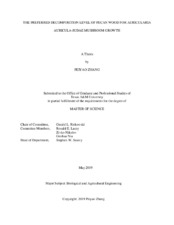| dc.contributor.advisor | Riskowski, Gerald L. | |
| dc.creator | Zhang, Peiyao | |
| dc.date.accessioned | 2019-12-11T17:14:37Z | |
| dc.date.available | 2019-12-11T17:14:37Z | |
| dc.date.created | 2019-05 | |
| dc.date.issued | 2019-04-01 | |
| dc.date.submitted | May 2019 | |
| dc.identifier.uri | https://hdl.handle.net/1969.1/186933 | |
| dc.description.abstract | As mushrooms always grow on wood which is already decomposed, fresh wood is not suitable for fungus to live. The object of this research was to find the preferred decay level of Pecan logs for Auricularia auricular-judae (wood ear mushroom) growth. Both the log cultivation and bag cultivation methods were used to grow wood ear mushrooms in this research. These mushrooms were cultivated in an environmental growth chamber, which could control the environmental conditions (temperature, light, moisture, etc.) for mushroom growth. Pecan wood was used to cultivate the mushrooms. Physical and chemical properties of the pecan logs were measured to find the relationships between these properties and decay levels of logs. There was a negative relationship between densities and decay levels of logs. The old decayed logs had lower densities than new fresh logs. Densities could be used as a basic standard to represent the decay levels. When the densities of logs were less than 430 kgm−3, the negative linear relationship was significant between log hardness and densities of logs. The relationship between C/N ratios and densities of logs was not significant, except for logs that already had fruiting residue present. Based on the log cultivation of wood ear mushroom, the spawn colonized, and mycelium appeared on logs with densities from 200 – 600 kgm-3. There was no significant relationship between the densities and C/N ratio of these logs. From the bag cultivation of wood ear mushroom, mushroom spawn colonized, and mycelium appeared in every bag. However, the growth conditions were different for each bag based on substrates. Growth bags with substrates made from logs with densities ranging 200 – 500 kgm-3 had better mycelium growth than high-density ranges. | en |
| dc.format.mimetype | application/pdf | |
| dc.language.iso | en | |
| dc.subject | Auricularia auricula-judae | en |
| dc.subject | Pecan log | en |
| dc.subject | log properties | en |
| dc.subject | decay levels | en |
| dc.subject | growth | en |
| dc.title | The Preferred Decomposition Level of Pecan Wood for Auricularia Auricula-Judae Mushroom Growth | en |
| dc.type | Thesis | en |
| thesis.degree.department | Biological and Agricultural Engineering | en |
| thesis.degree.discipline | Biological and Agricultural Engineering | en |
| thesis.degree.grantor | Texas A&M University | en |
| thesis.degree.name | Master of Science | en |
| thesis.degree.level | Masters | en |
| dc.contributor.committeeMember | Lacey, Ronald E. | |
| dc.contributor.committeeMember | Zivko, Nikolov | |
| dc.contributor.committeeMember | Niu, Genhua | |
| dc.type.material | text | en |
| dc.date.updated | 2019-12-11T17:14:37Z | |
| local.etdauthor.orcid | 0000-0002-3698-4481 | |


